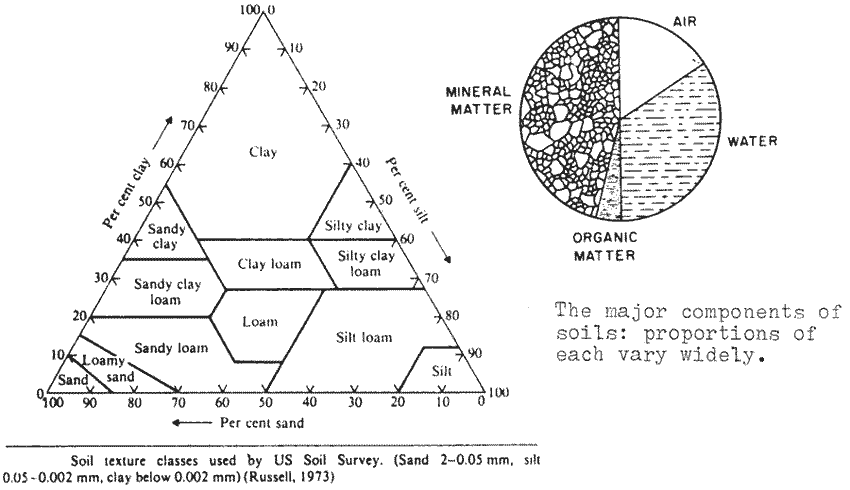
SOME ASPECTS OF SOIL CHEMISTRY AND PHYSICS
What is Soil?
Soils are composed of five main components:
(From: CSIRO, Soils, 1977)
The ratio of water, air and soil is important to plant growth. Water-logging or dry soil are detrimental and stressful to plants. In soils other than coarse sand, the volume of the soil itself changes with water content.
Particle size is important to drainage and water holding capacity of a soil. Generally, smaller particle size increases water holding and impairs drainage. Coarser soils absorb water more rapidly. Of course, most soils are mixtures; however soil characteristic are most easily explained on 'pure' types.
Gravel, coarse sand, fine sand, silt and clay have a descending order of particle size. Clay particles are less than 1/2000th of a millimetre in diameter. One gram of clay can have a surface area of over one hectare!
As sand has no organized structure, no texture or cracks are seen in a soil cutting. A cutting also shows the various soil horizons. The quality of the top metre or two is important to the orchardist.
A sponge saturated in water is a useful model to demonstrate water-holding capacity. Water-holding capacity varies, not only with particle size but is also changed by other factors, notably organic content. An organic content of at least 2% - in fact a huge quantity - can be most useful in improving a soil's water-holding capacity and availability of water to plants. This means that although a soil may not be quite dry, a plant can extract only down to a certain percentage of water from a soil. Clays hold more water than sands; however clays will retain a greater amount of water before causing plant stress.

Organic matter and clays have the ability to hold nutrient minerals. At a certain pH, some nutrients will be available and others are locked up. The correct pH (acidity/alkalinity) range is therefore important.
Organic content is improved through the addition of manure and mulching. Mulching has two further benefits:
1. Soil temperature above 28°C tends to be harmful to surface rootlets. Mulching keeps soil temperature down.
2. Mulch will retain soil moisture.
Increasing organic content through mulching is a most important method available for maintaining and improving a soil, whether the fruit tree grower holds a patch of sand, clay or loam.
DATE: September 1981
* * * * * * * * * * * * *
